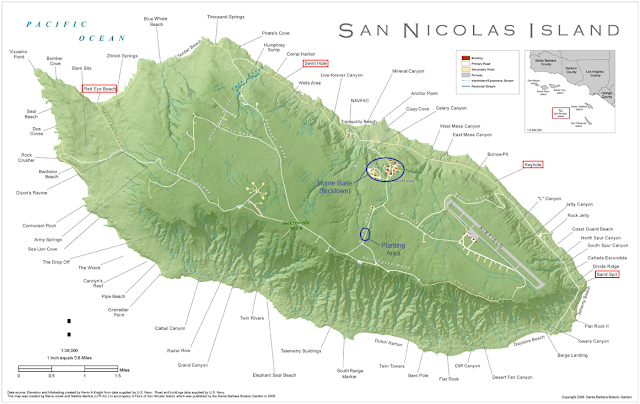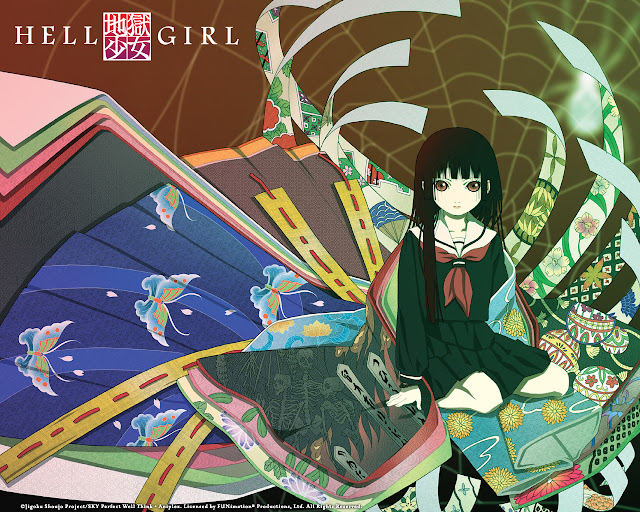The Order of the Thorn
It wasn't until the end of my fourth day on San Nicolas Island that I realized I'd been holding an endangered species in the palm of my hand.

The little white plants, so small and fragile looking that I kept having to make sure I wasn't burying them in the dirt, were San Nicolas Island buckwheat. Just like the island foxes or the scrub jays on Santa Cruz Island, the local buckwheat plants have evolved to the point where they were different from their mainland relatives. (The foxes, in fact, are different subspecies from island to island.) The next day, on our last morning of planting, I took extra care to make sure I planted them properly.
Native Americans lived on San Nicolas for thousands of years, and got along just fine. Then in the 1800s, we Europeans showed up and decided we could use the island for sheep ranching. Within a few decades, the place was trashed. The sheep thrived during the rainy years, then ate everything during the dry years. With no plants holding the topsoil in place, the stiff Pacific Ocean winds literally started blowing the island away. I was startled to see the island's eastern end as we flew in to the Navy base's airport. It looks like a barren wasteland. The same thing happened on many of the other islands.
(Incidentally, when Interior Secretary Ryan Zinke visited the Channel Islands last year - incurring some dubious travel expenses in the process, I might add - he started saying they should build a "working ranch demonstration project" on Santa Rosa Island, to call attention to the islands' "ranching heritage." Oh yes, let's remind everyone how we almost destroyed an entire ecosystem. Your tax dollars at work.)
I've never been much of a plant person. My mom is, but I did not inherit the green thumb. But even I was able to get into the job of planting the 1800 native plants we did. Plant by plant, we were giving the native wildlife a new start and a new chance to grow.

Here's something else we planted, the Channel Islands Silver Lotus. It's a bit more fragile than the buckwheat, though, so we didn't plant any on windy days. Other plants included various types of grass, yarrow and prickly pear cactus. That last one was tricky, because obviously you can't grab a cactus with your hand when you try to get it out of the pot it's been growing in. Well, you can, but believe me, you don't want to. Fortunately, I learned a handy trick with a big set of tongs. Place the tongs around the cactus, and then turn the whole thing upside down. The potting soil will rest on the tongs while you wriggle the pot off, and once it's off, you can grab the potting soil with your hand to put the cactus in the ground. I got pretty good at that, although of course I still got poked a few times. There's a reason why San Nicolas volunteers are called "The Order of the Thorn."
Speaking of us volunteers, and the staff leaders too, even an introvert like me can learn a lot about people by spending several days planting plants with them. At least half the volunteers were retirees, and I think I was the oldest of the non-retirees. A couple of the people already knew each other - two retired women who go rowing together on Lake Casitas (!) - and a couple knew the staff from previous planting trips. The youngest was a woman who had graduated from UCSB in environmental science a few years ago, and was getting ready to go back for her Masters. She had lived in Japan as a teenager too, where her height (roughly the same as mine) made her popular on volleyball teams. The project leader reminded me of the man who ran the Natural Science section at the Indianapolis Children's Museum back when I volunteered there in the 70s. I jokingly asked if that had been his dad.


Two plants we didn't have to plant were the Dudleya and the Coreopsis. Dudleya already fascinated me, because a lot of them look like they were spray-painted white. I've seen them on the mainland as well as on the islands, and they're the symbol of Channel Islands Restoration. The Coreopsis are the closest thing to trees on much of San Nicolas. They have a dormant mode where they appear dried up and dead, but when they get enough water, they come to life and bloom with brilliant yellow flowers.
I must say that I came back from my five-day tour with a newfound appreciation for anyone who does agricultural work. It's freakin' hard. I drive past all kinds of fields going to and from my office job every day - strawberries, peppers, onions, citrus, broccoli and other things - and after my experience, I have a lot of respect for the people I see out there. They bust their rear ends so that you and I can have all that lovely produce we see in our grocery stores. Never forget that. Just over this past week, I've seen long lines of pots being laid out in one of the fields, and now I know what they're about to do.
Would I go out there again? Absolutely. I don't know whether I'll make it back to San Nicolas (I'd certainly like to), but there are similar projects on the other islands. There are projects that take kids out there too, and I'd like to see what that experience is like, so I can write about it. San Nicolas was my first island restoration experience, but it's not going to be my last.

The little white plants, so small and fragile looking that I kept having to make sure I wasn't burying them in the dirt, were San Nicolas Island buckwheat. Just like the island foxes or the scrub jays on Santa Cruz Island, the local buckwheat plants have evolved to the point where they were different from their mainland relatives. (The foxes, in fact, are different subspecies from island to island.) The next day, on our last morning of planting, I took extra care to make sure I planted them properly.
Native Americans lived on San Nicolas for thousands of years, and got along just fine. Then in the 1800s, we Europeans showed up and decided we could use the island for sheep ranching. Within a few decades, the place was trashed. The sheep thrived during the rainy years, then ate everything during the dry years. With no plants holding the topsoil in place, the stiff Pacific Ocean winds literally started blowing the island away. I was startled to see the island's eastern end as we flew in to the Navy base's airport. It looks like a barren wasteland. The same thing happened on many of the other islands.
(Incidentally, when Interior Secretary Ryan Zinke visited the Channel Islands last year - incurring some dubious travel expenses in the process, I might add - he started saying they should build a "working ranch demonstration project" on Santa Rosa Island, to call attention to the islands' "ranching heritage." Oh yes, let's remind everyone how we almost destroyed an entire ecosystem. Your tax dollars at work.)
I've never been much of a plant person. My mom is, but I did not inherit the green thumb. But even I was able to get into the job of planting the 1800 native plants we did. Plant by plant, we were giving the native wildlife a new start and a new chance to grow.

Here's something else we planted, the Channel Islands Silver Lotus. It's a bit more fragile than the buckwheat, though, so we didn't plant any on windy days. Other plants included various types of grass, yarrow and prickly pear cactus. That last one was tricky, because obviously you can't grab a cactus with your hand when you try to get it out of the pot it's been growing in. Well, you can, but believe me, you don't want to. Fortunately, I learned a handy trick with a big set of tongs. Place the tongs around the cactus, and then turn the whole thing upside down. The potting soil will rest on the tongs while you wriggle the pot off, and once it's off, you can grab the potting soil with your hand to put the cactus in the ground. I got pretty good at that, although of course I still got poked a few times. There's a reason why San Nicolas volunteers are called "The Order of the Thorn."
Speaking of us volunteers, and the staff leaders too, even an introvert like me can learn a lot about people by spending several days planting plants with them. At least half the volunteers were retirees, and I think I was the oldest of the non-retirees. A couple of the people already knew each other - two retired women who go rowing together on Lake Casitas (!) - and a couple knew the staff from previous planting trips. The youngest was a woman who had graduated from UCSB in environmental science a few years ago, and was getting ready to go back for her Masters. She had lived in Japan as a teenager too, where her height (roughly the same as mine) made her popular on volleyball teams. The project leader reminded me of the man who ran the Natural Science section at the Indianapolis Children's Museum back when I volunteered there in the 70s. I jokingly asked if that had been his dad.


Two plants we didn't have to plant were the Dudleya and the Coreopsis. Dudleya already fascinated me, because a lot of them look like they were spray-painted white. I've seen them on the mainland as well as on the islands, and they're the symbol of Channel Islands Restoration. The Coreopsis are the closest thing to trees on much of San Nicolas. They have a dormant mode where they appear dried up and dead, but when they get enough water, they come to life and bloom with brilliant yellow flowers.
I must say that I came back from my five-day tour with a newfound appreciation for anyone who does agricultural work. It's freakin' hard. I drive past all kinds of fields going to and from my office job every day - strawberries, peppers, onions, citrus, broccoli and other things - and after my experience, I have a lot of respect for the people I see out there. They bust their rear ends so that you and I can have all that lovely produce we see in our grocery stores. Never forget that. Just over this past week, I've seen long lines of pots being laid out in one of the fields, and now I know what they're about to do.
Would I go out there again? Absolutely. I don't know whether I'll make it back to San Nicolas (I'd certainly like to), but there are similar projects on the other islands. There are projects that take kids out there too, and I'd like to see what that experience is like, so I can write about it. San Nicolas was my first island restoration experience, but it's not going to be my last.


Comments